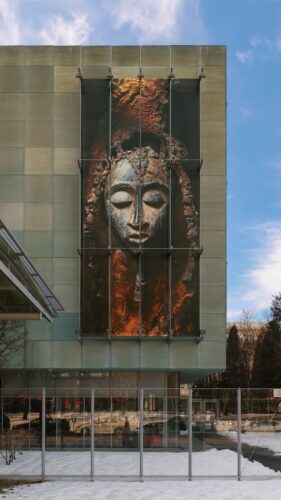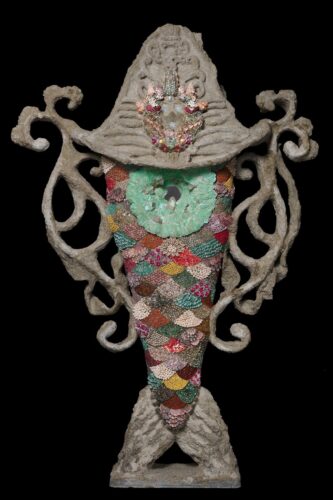Visual Arts Review: “Waters of the Abyss” — Beautiful Testaments to Haitian Resistance
By Lauren Kaufmann
While offering a window into artist Fabiola Jean-Louis’s examination of her cultural and personal identity, the exhibit also provides a deeper understanding of the Haitian struggle for freedom.
Waters of the Abyss: An Intersection of Spirit and Freedom at the Isabella Stewart Gardner Museum, Boston, through May 25.

Fabiola Jean-Louis: Ayiti-Tomè, 2025, Anne H. Fitzpatrick Façade. Photo: Isabella Stewart Gardner Museum, Boston
Many cultural institutions are under attack from the current administration, losing staff and funding, so it’s encouraging to see organizations willing to shed light on the stories of marginalized groups. Waters of the Abyss: An Intersection of Spirit and Freedom, a new exhibition at the Isabella Stewart Gardner Museum, centers on the work of Haitian-born artist Fabiola Jean-Louis.
Most of the exhibition is installed in the Hostetter Gallery, housed in the museum’s modern addition, while a small portion hangs in the Fenway Gallery, in the original building. But before you step inside, stop and look up at the façade of the building. Jean-Louis has merged photographs of Haiti with early versions of the sculptures from the exhibition. The phrase Ayiti-Tomè appears on the building. Written in Fon, a language spoken by the enslaved African people of Haiti, the phrase means, “From now onward this land is our land.”
Inside the museum, the introductory wall text posits the critical question: What lies at the heart of Black freedom? Jean-Louis’s art responds to this question by tapping into images of the spiritual world that have shaped Haiti’s culture and history. Using papier-mâché, shells, sand, gold, glass, and crystals, Jean-Louis creates vessels, busts, and sculptures that reflect on the supernatural life that ultimately led to revolution and the birth of the first free Black nation in the Americas.
Throughout the exhibition, the wall texts appear in English and in Haitian Creole. Given that there are nearly 70,000 Haitian immigrants and descendants living in the Boston area, the Gardner is providing a critical service to Haitian visitors, who are likely to find this exhibition a welcome retreat from the current air of fear and retribution plaguing the country.

Fabiola Jean-Louis, All That Was and Nevermore, 2024. Photo: Isabella Stewart Gardner Museum, Boston
Jean-Louis was born in Port-au-Prince, but moved to New York when she was 10 years old. The country’s rich cultural history stuck with her, and her work draws deeply on its religious traditions. The role of Vodou is central to her work, as it was to Haiti’s ultimate liberation from its slaveholders.
By the late 1790s, there were 500,000 enslaved people living in Saint-Domingue, now known as Haiti. They were deported for the production of sugar cane and coffee. Slave masters treated the enslaved people cruelly, robbing them of their dignity and their religious traditions. Catholicism was forced on them, and in response the enslaved people living in Saint-Domingue chose to embrace the cult of the dead as a way to connect with their African traditions. They believed that death was the way back to their ancestors. Because enslaved people had been ripped away from their families and their lineage, they felt that death provided the only way back.
The practice of Vodou integrated reverence for Catholic saints with the cult of the dead. In Vodou temples, ceremonies connected the earthly and celestial worlds, conduits for the living to communicate with the deceased. In the first gallery of the exhibition, Jean-Louis presents a wall of objects, made of papier-mâché, that honor her Haitian ancestors. Each object sits in an illuminated niche; the overall effect creates a stunning glow. The gallery also features two busts, self-portraits, made of papier-mâché, gold, crystal, sea sponge, and stone. In Out of Obsidian, Jean-Louis inserts flowers in the stone, and in Peregrine, she combines a mountain perch with a waterfall and tree in bloom. Although they were made last year, these pieces feel ancient, handmade, and sacred.
In the adjacent gallery, Jean-Louis focuses on the Haitian fight for freedom. The wall text explains how the Haitian revolution began on an August night in 1791, when a Vodou ceremony brought together hundreds of enslaved people who called on the spiritual world to assist them in overthrowing French colonial rule. The art in this gallery speaks to the power of art in stimulating change. A quotation from the artist conveys the connection between the ancestral past and the struggle for liberation: “When Black people pay attention to where we actually come from and the things that spiritually inspire and guide us, we are a stronger people. We can overcome and we will overcome.”

Fabiola Jean-Louis, Mermaid Portals, 2024. Photo: Isabella Stewart Gardner Museum, Boston
A series of four sculptures, each entitled An Entry Point to Heaven, evokes the connection between the sea and the sky. With papier-mâché, shells, crystals, glass, resin, and sea sponge, Jean-Louis reimagines the Haitian seascape, complete with water, mountainous cliffs, and volcanic craters. A quotation from the artist expresses the interlinked relationship: “The ocean is the mirror to the sky and the heavens. When I talk about the ocean, I am talking about heaven as well. They are the yin and the yang, or perhaps the same things.”
The role of water is essential to Haiti’s culture and to Jean-Louis’s work. She has created the sculptures in this gallery as portals, meeting places for people and spirits. A pair of Mermaid Portals and a Celestial Portal are placed in the center of the gallery. Made of shells, crystals, mirrors, and papier-mâché, these pieces are carefully crafted to look as if they were pulled from the sea. The text explains that, in Vodou culture, the mermaid can be an enchantress or a figure of vengeance. Clearly, she plays a pivotal role in Haiti’s spiritual world.
In addition to sculptural work, this gallery features sound, produced to evoke ocean waves, bells, wind chimes, and a conch shell. Reflecting the natural sounds heard in Haiti, the soundscape adds another layer to the environment created by the artwork. On the day that I visited, the volume was unobtrusive, creating a subtle yet apt way to enhance visitor appreciation for the culture.
The remainder of the exhibition is installed in the Fenway Gallery. Here, Jean-Louis explores her own identity as a woman of Haitian descent. Having served as an artist-in-residence at the Gardner Museum, Jean-Louis had a chance to explore the sacred objects and altars throughout the museum. Bringing visitors into this gallery is a way to encourage them to roam around and perhaps see some of the objects prized by Isabella Stewart Gardner.
In All That Was and Nevermore, Jean-Louis reflects on her past, showing herself marrying a man in a Christian ceremony. She includes three images of her children, adorned in clothing typical of wealthy women and men at the time of the Haitian Revolution. In this work, Jean-Louis employs crystals, sequins, beads, and mixed media to create a multilayered picture. The frame of the painting looks like a tombstone, echoing the intimate, death-centered relationship between the Haitian people and the spiritual world.

Waters of the Abyss: An Intersection of Spirit and Freedom in the Hostetter Gallery. Photo: Isabella Stewart Gardner Museum, Boston
There are two dresses in this gallery. One, commissioned by the Metropolitan Museum of Art in 2021, resembles a corset dress from the 1700s. The model wears a brooch that alludes to Ezili Dantor, who embodied the Vodou spirit of vengeance, justice, and motherhood. Dantor is said to have inspired the Haitian Revolution. Jean-Louis made the second garment for a self-portrait series called Atonement. The wall text describes how this dress represents the fear and guilt that she suffered while attending Catholic school, an experience that separated her from her Haitian ancestry.
While offering a window into Jean-Louis’s examination of her cultural and personal identity, the exhibit also provides a deeper understanding of the Haitian struggle for freedom. In this time of repression and cruelty, the Gardner Museum should be applauded for challenging us to think and learn about the critical history of Haitian liberation. The message of Waters of the Abyss is more needed now than it might have been a year ago.
Lauren Kaufmann has worked in the museum field for the past 14 years and has curated a number of exhibitions. She served as guest curator for Moving Water: From Ancient Innovations to Modern Challenges, currently on view at the Metropolitan Waterworks Museum in Boston.
